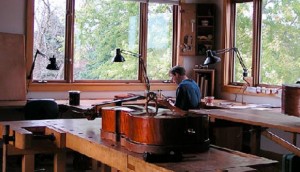I have information available for new, custom-built instruments, replicas, and baroque/transitional instruments. To read more about the differences between old and new instruments, see Old vs. New in my Articles section.
From the time I was a young child, I have been fascinated by the beauty and versatility of wood. I have a vivid memory of, as a four-year-old, digging through my father’s board pile, looking for just the right piece of wood for a toy I wanted to make. As I sawed and nailed and carved, I felt a deep power of transformation, of taking something apparently plain and ubiquitous, and changing it into something beautiful and desirable (at least to my four-year-old eyes). I still feel the same way: to take a piece of maple and a piece of spruce, and turn it into a violin or viola or cello is almost like making magic.
No less formative was the experience of growing up as one of four violinists in my household, two of whom went on to become professional musicians. Violins and violin music were part of the air I breathed as a child. That early and continuing experience has developed in me an ear that is well attuned to the nuances of sound production.
This early association with violins and woodworking led me directly to me enrollment, at the age of eighteen, in The violinmaking School of America in Salt Lake City, and my subsequent graduation from that school in 1983.
Since that time, I have focused all of my energy and attention on building some of the finest violins, violas, and cellos made in the world today. I have won dozens of medals and awards for my instruments in major international violinmaking competitions. I have made more than 200 violins, violas, and cellos (along with three bases) which are being played in major orchestras and conservatories across the United States and Europe.
I am a member of the American Federation of Violin and Bow Makers and have been made Hors Concours by the Violin Society of America. My instruments are at times also used in non-classical settings, such as the cello rock group Cello Fury.
Matched Trios and Quartets
I have a special interest in making quartets and trios that fit together tonally. I am the only violin maker who has won two gold medals in the Violin Society of America’s quartet-making competition. Often, the problem with a quartet’s sound is that the middle voices don’t come through as well as they should. When I make the instruments in a “matched quartet,” I am always thinking and concerning myself with matching the sound of all the voices in the quartet, and giving those middle voices the strength and sonority to be heard by the audience. Each member of the quartet should be a great instrument individually, but be able to fit in and blend with the others when it is time to do so. I want all of the instruments in a quartet or trio to be able come to the forefront when it their time, and then blend in perfect harmony when it is time for another part to take the lead.

